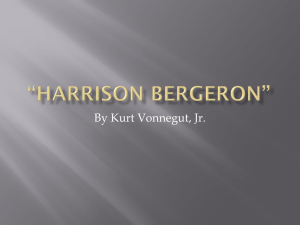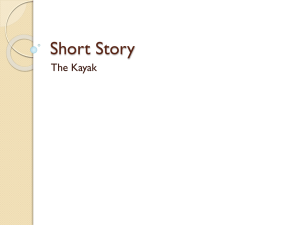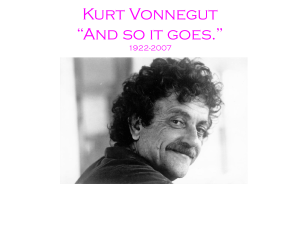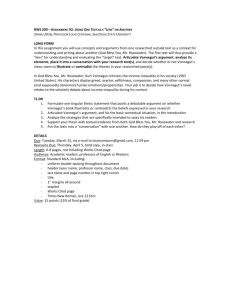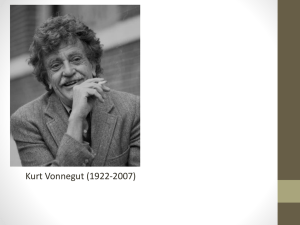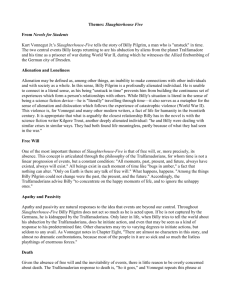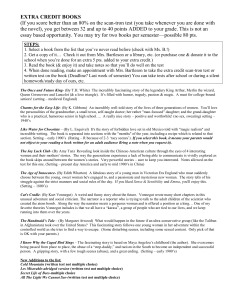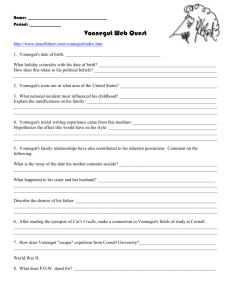Slaughter_House_5_Annotated_Bib
advertisement
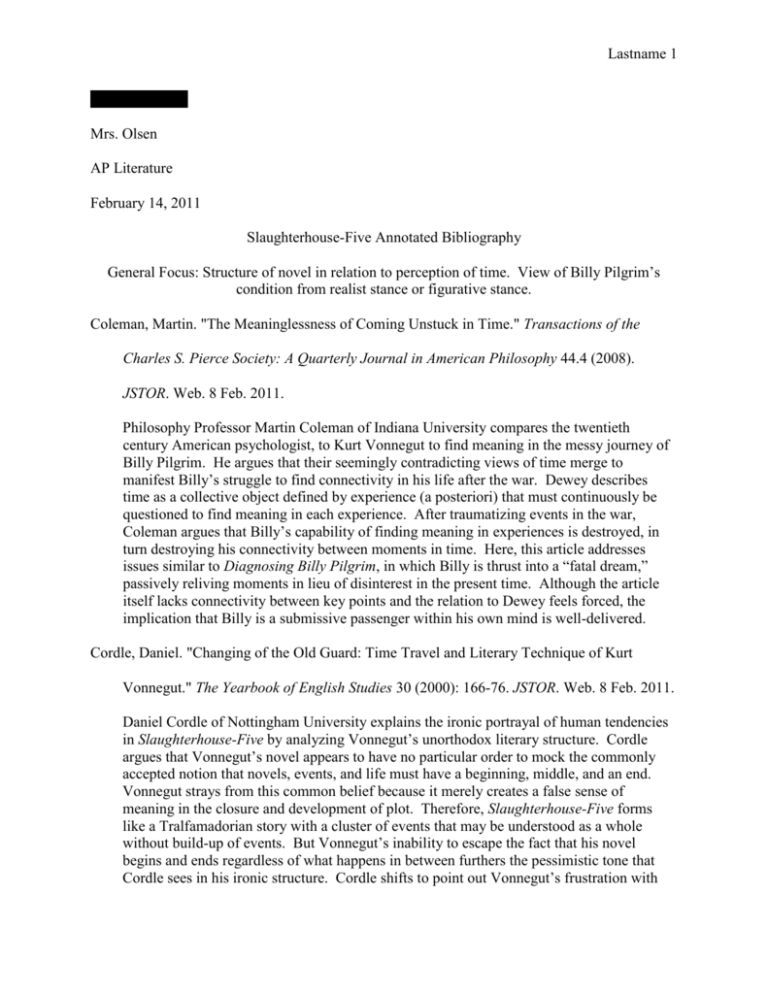
Lastname 1 Kevin Milewski Mrs. Olsen AP Literature February 14, 2011 Slaughterhouse-Five Annotated Bibliography General Focus: Structure of novel in relation to perception of time. View of Billy Pilgrim’s condition from realist stance or figurative stance. Coleman, Martin. "The Meaninglessness of Coming Unstuck in Time." Transactions of the Charles S. Pierce Society: A Quarterly Journal in American Philosophy 44.4 (2008). JSTOR. Web. 8 Feb. 2011. Philosophy Professor Martin Coleman of Indiana University compares the twentieth century American psychologist, to Kurt Vonnegut to find meaning in the messy journey of Billy Pilgrim. He argues that their seemingly contradicting views of time merge to manifest Billy’s struggle to find connectivity in his life after the war. Dewey describes time as a collective object defined by experience (a posteriori) that must continuously be questioned to find meaning in each experience. After traumatizing events in the war, Coleman argues that Billy’s capability of finding meaning in experiences is destroyed, in turn destroying his connectivity between moments in time. Here, this article addresses issues similar to Diagnosing Billy Pilgrim, in which Billy is thrust into a “fatal dream,” passively reliving moments in lieu of disinterest in the present time. Although the article itself lacks connectivity between key points and the relation to Dewey feels forced, the implication that Billy is a submissive passenger within his own mind is well-delivered. Cordle, Daniel. "Changing of the Old Guard: Time Travel and Literary Technique of Kurt Vonnegut." The Yearbook of English Studies 30 (2000): 166-76. JSTOR. Web. 8 Feb. 2011. Daniel Cordle of Nottingham University explains the ironic portrayal of human tendencies in Slaughterhouse-Five by analyzing Vonnegut’s unorthodox literary structure. Cordle argues that Vonnegut’s novel appears to have no particular order to mock the commonly accepted notion that novels, events, and life must have a beginning, middle, and an end. Vonnegut strays from this common belief because it merely creates a false sense of meaning in the closure and development of plot. Therefore, Slaughterhouse-Five forms like a Tralfamadorian story with a cluster of events that may be understood as a whole without build-up of events. But Vonnegut’s inability to escape the fact that his novel begins and ends regardless of what happens in between furthers the pessimistic tone that Cordle sees in his ironic structure. Cordle shifts to point out Vonnegut’s frustration with Lastname 2 the gap between human’s scientific evolution as creatures and a true meaning in the midst of that arbitrary development, using Galapagos as evidence. Vonnegut’s view of time as a series of accidents that have been predetermined removes the sense of purpose humans attempt to find in life, mirrored by the absurdity that Vonnegut’s simplistic narrative voice draws such deep metaphysical evaluation. Edelstein, Arnold. "Slaughterhouse-Five: Time out of Joint." College Literature 1.2 (1974): 12839. JSTOR. Web. 8 Feb. 2011. Arnold Edelstein, 1985 Fulbright Scholar for American literature and professor at the University of Hawaii, places Vonnegut’s novel in chronological order to make sense of Billy Pilgrim’s complex timeline. Upon examining the real-time structure, Edelstein points out, like many other scholars, that Billy retreats into his own mind as an escape from the reality of the present; for in the present, one is left with merely the memories that stand out, and in this case, the trauma of Dresden plagues his daily activity. Unlike other articles, however, he analyzes Vonnegut’s careful construction of linkage-devices as “seeds” for his dreamlike second-reality, replacing the aura of fantasy with plausible explanations for reminders of the past. He also takes a fresh approach to analyzing Vonnegut’s “out of joint” structure as a means of holding off suspense until the final realization in the bookstore that Billy’s fantasies are fiction—a realization so abrupt it is comparable to Billy’s more traumatic realization in Dresden. May, John R. "Vonnegut's Humor and Limits of Hope." Twentieth Century Literature 18.1 (1972): 25-36. JSTOR. Web. 8 Feb. 2011. John May of Loyola University seeks to declassify Vonnegut’s complete set of works as black humor while identifying it as a desperate plea for people to avoid destructive optimism. May divides Vonnegut’s work into two groups to illustrate the evolution of Vonnegut’s pessimism. The structure of the essay fades, however, often resorting to passage summarization that would have created an insightful interpretation with more analysis (Very Kilgore Trout-esque, “His prose was frightful. Only his ideas were good”). May argues that the contrast between Vonnegut’s subject matter and his very disconnected authorial voice have the ironic structure of black humor, but Vonnegut’s traumatic connection to Dresden centers the focus of the irony more on the pessimism of humanity and war. The repetition of “so it goes,” for example, appears to be Vonnegut’s own attempt to console himself from the widely accepted finality of death; the phrase grows increasingly more unsettling as the novel continues, however, eventually bearing heavy emotional implication when it was originally intended to remove. May, unlike most other scholars, does not see any evidence of optimism in lieu of Vonnegut’s plea for pessimism. Lastname 3 Miller, Gavin. "Literary Narrative as Soteriology in the Work of Kurt Vonnegut and Alasdair Gray." Journal of Narrative Theory 31.3 (2001): 299-323. Project MUSE. Web. 8 Feb. 2011. Dr. Gavin Miller of the University of Edinburgh carefully scrutinizes Vonnegut’s impetus for writing Slaughterhouse-Five, and the circumstances that created a perception of time comparable to Kant, Sartre, Proust, Schopenhauer, Saint Augustine, and Tolstoy. Dr. Miller steps beyond the common analysis of Billy Pilgrim’s view of time and analyzes why Vonnegut created such a vapid character, ultimately concluding that “there is nothing intelligent to say about a massacre.” Vonnegut emerged from one of the most expensive and destructive bomb campaigns in military history and the irony of his fortuitous survival is so grand that even understatement would not do the cultivated emotions justice. Although the language of the comparisons are dense, Dr. Miller synthesizes numerous philosophical texts to justify Vonnegut’s unorthodox approach, deciding that Vonnegut’s situation compelled him to steer away from traditional structure so as not to glean any excuses for the inhumanity of mankind. Rubens, Philip M. ""Nothing's Ever Final": Vonnegut's Concept of Time." College Literature 6.1 (1979): 64-72. Project MUSE. Web. 8 Feb. 2011. Philip M. Rubens of East Carolina University compares Vonnegut’s use of time in The Sirens of Titan and Slaughterhouse-Five to assert similarities between French philosopher Henry Bergson’s philosophies and Vonnegut’s. Rubens notes that The Sirens of Titans creates an image of time as a tangible force that has and will eternally exists as long as individuals “internalize their memory of time,” a direct quote from Bergson’s writings. Both Vonnegut and Bergson argue that man merely bounces from moments to moments which have already happened, but the lack of free will encourages people to stop creating and innovating, because what will happen will inevitably happen regardless. Rubens argues that Slaughterhouse-Five provides a “new, optimistic perspective on history,” necessary to counteract complacency. Although he does not create a compelling argument for the optimism within the novel, the orderly juxtaposition of the Sirens of Titan proposing a misconception and Slaughterhouse-Five providing a moment of epiphany to cope with it, makes sense. Billy steps beyond the ignorance of humans to the connectivity of moments and trusts his own abilities to guide himself from moment to moment, providing an escape from his present world destroyed by the realities of his past. Uphaus, Robert W. "Expected Meaning in Vonnegut's Dead-End Fiction." A Forum on Fiction 8.2 (1975): 164-74. JSTOR. Web. 8 Feb. 2011. Robert Uphaus of Duke University explores the works of Kurt Vonnegut to find meaning in his seemingly hopeless novels that foresee an eternity of despair; he concludes Vonnegut seeks to emphasize the tight duality of imagination and death. In Slaughterhouse-Five Lastname 4 Vonnegut handles the psychic response to this endless cycle, using his own traumatic experience at Dresden to display the mind-altering power of humans. Emerging from the war, Billy’s actions reflect a “numbness” that stems from an overexposure of emotion in s confined period rather than a loss of feeling overall. Billy finds the reality he now knows unlivable, therefore his imagination creates a new world history without the harsh reality of death, war, and time. Uphaus sees a parallel between Billy’s response to the war and Vonnegut’s own response. Unlike others, however, he addresses the present day of Vonnegut, claiming that the imaginary world in which he is brought back to Dresden provides an escape from the rampant materialism of society. His frustration with humanity is also reflected Vonnegut’s quote that “laughter is a response to frustration, just as tears are, and it solves nothing,” tying into the assertion of an endless cycle void of closure. Vees-Gulani, Susanne. "Diagnosing Billy Pilgrim: A Psychiatric Approach to Kurt Vonnegut's Slaughterhouse-Five." Critique: Studies in Contemporary Fiction 44.2 (2003): 175-84. JSTOR. Web. 8 Feb. 2011. Susanne Vees-Gulani, a comparative literature professor at Case-Western University with a doctorate in the subject uses psychiatric techniques to evaluate Billy Pilgrim’s condition in Slaughterhouse-Five. Drawing from several medical journals, Vees-Gulane explains Billy’s time-travels as an out-of-body phenomenon commonly associated with Post Traumatic Stress Disorder. Critics of the novel argue whether or not Billy’s story should be approached from a literal or figurative standpoint, generally with mere speculation of Vonnegut’s intent. This article analyzes Vonnegut’s own wartime traumas and logically ties them to Billy’s attempt to cope with the war. Vees-Gulani avoids sweeping claims about the ideological images of the book, and creates a logical viewpoint for readers to analyze the book’s complexities.
